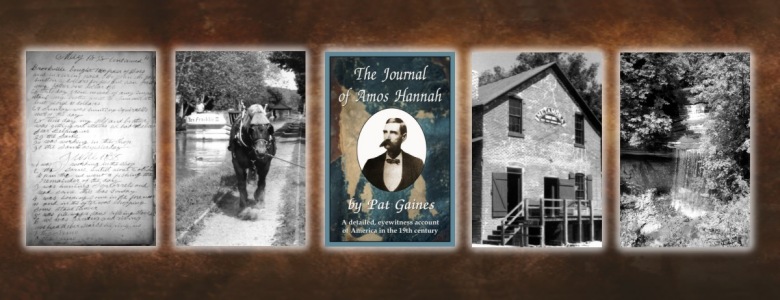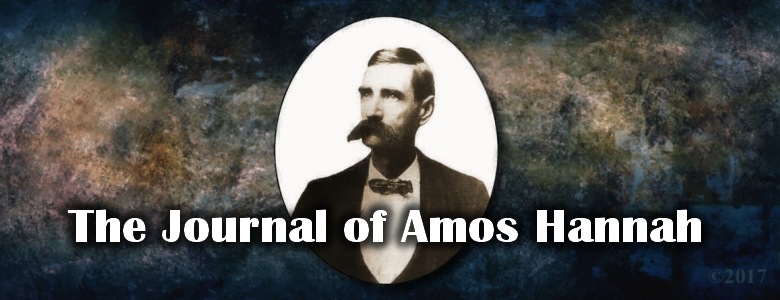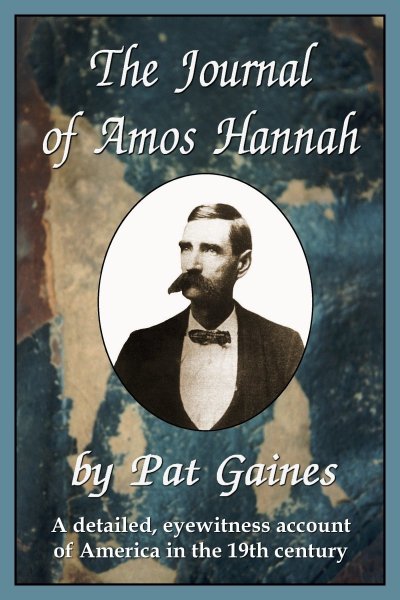PAT GAINES Author Website
THE JOURNAL OF AMOS HANNAH
A detailed eyewitness account of America in the 19th century, the personal journal of Amos Hannah was written from 1838 to 1850. It outlines his daily life from Brookville, Indiana, to his arrival at the gold fields of California. Amos Hannah was a cooper (i.e. barrel maker), who raised a family, traveled extensively, and chronicled the events and concerns of his day.
Print editions include: table of contents; the complete 1838-1850 journal; letters from the era, including one from Panama; Justice of the Peace documents from Kansas Territory; explanations of archaic terminology; over two dozen photographs and illustrations in black and white; European genealogy in time-line overview; Early American genealogy in detailed time-line; Bibliography; Appendices (some illustrated); plus an extensive index (alphabetical by name and topic).
THE JOURNAL OF AMOS HANNAH [©2005-2025] by Pat Gaines | Non-Fiction / Biography / Early American History (256 pages) | Generously illustrated in black/white | Available in paperback and hardback from the DFP Books label of Dragonfly Publishing, Inc.
BOOK COVER
SALES LINKS
See inside the book at Amazon and Barnes & Noble
LIBRARY PAPERBACK [EAN 978-0-9817049-7-5 | ISBN 0-9817049-7-2] 6x9 library trim (256 pages) B/W | Average Retail Price: $11.99
LIBRARY HARDBACK [EAN 978-1-941278-70-3 | ISBN 1-941278-70-1] [EAN 978-09787421-5-7 | ISBN 0-9787421-5-X] 6x9 library trim (256 pages) B/W |Average Retail Price: $21.99
CLOTHBOUND WITH DUST JACKET [EAN 978-09755888-8-5 | ISBN 0-9755888-8-5] 6x9 library trim (256 pages) B/W [out-of-print]
REVIEWS
"The California Gold Rush generated an unprecedented body of eyewitness narrative accounts rivaled only by the Civil War. New and fresh documents continue to surface and Pat Gaines has skillfully edited and brought to light the journal and Gold Rush letter of her great-great-grand- father Amos Hannah. In this generously illustrated volume filled with a wealth of support material, editor Gaines reproduces Hannah's journal that concludes in 1850 with the Gold Rush and a detailed letter describing the Panama crossing. Amos, a faithful diary keeper, had maintained a daily record since 1838 and his journal provides a wonderful insight into the life of this Hoosier. Like so many others, Hannah, while toiling in his hometown of Brookville, Indiana as a cooper, was bitten by gold fever and made plans to go to California to make his pile. He struck a bargain with a R. Barwick to dig for gold in exchange for supporting his expenses on the long trek to the golden land. By April 1850, Hannah recorded in his journal that he was heading for the placers via the Panama route. By that year, the route through the exotic isthmus proved to be the quickest way to the diggings rather than by the tedious and perilous 18,000 mile voyage around Cape Horn or the equally tedious and physically challenging journey across the continent by way of the California Trail. Hannah and companions took a steamship from Cincinnati down the Ohio and Mississippi to New Orleans. After a short stay in the Crescent City, they steamed across the Gulf of Mexico on board the Alabama arriving in Panama on May 22nd. From there, they followed the Chagres River through the steaming jungle to the Pacific Ocean side and picked up a San Francisco bound ship on June 11th. The unnamed French vessel took them to Honolulu, Hawaii (then called the Sandwich Islands) where Hannah recovered from an illness caused by the tainted food, lack of water, and vermin encountered on his ship. Finally, on August 13th, he made it to San Francisco, that great port city of the Gold Rush. Taking on provisions, the gold hunter headed to the northern diggings arriving at that roaring mining camp on the Feather River known as Bidwell Bar. No doubt weakened by the long voyage, he complained of sore legs following a fifty-mile walk. Unfortunately, Hannah ended his journal on August 18th with the simple statement: "Went to work." Most Argonauts terminated their journals with their arrival in the mines. The back- breaking work of mining and making money left little time or energy for writing up the day's events. His skills as a cooper probably would have yielded a much greater reward than working a long tom or rocker. By 1854, Amos was back in the Midwest, and fortunately, he carried back that most precious of all items, his journal. While Hannah's journal entries are not lengthy or filled with deep insights on the meaning of this great adventure thousands of miles from home, his letter from Panama dated May 31, 1850, is as prized as a bag of gold dust. Panama with its tropical vegetation and native peoples was unlike anything previously encountered by Americans. He remarked: 'The scenery along its banks (Chagres River) can not be beat in the world.' This Midwesterner and his companions soon found out, however, that this narrow strip of land separating two great oceans was anything but a paradise. Panama fever, poor food, high prices, and land pirates were all too common. The rush to California encouraged greed as more money could be made fleecing eager gold seekers than by digging for nuggets. Much to his disgust, Hannah discovered that it was his fellow countrymen and not the Panamanians who were doing the gouging. In securing passage to California, Hannah noted with shame: 'A greater set of rascals than are here the world can not scrape up and these I am sorry to say are Americans most all.'" ~ reviewed by Gary F. Kurutz, Curator of the California State Library, and author of The California Gold Rush: A Descriptive Bibliography of Books and Pamphlets Covering the Years 1848-1853 and half a dozen articles on the run for gold [FIVE STARS]
"Personal journals frequently give views of everyday life that you don't get from discussions of facts and observations that are found in most most historical publications. In her new book, THE JOURNAL OF AMOS HANNAH, Pat Gaines explores the life of her great-great-grandfather, who was born in Portsmouth, Ohio and moved with his family near Cedar Grove six miles south of Brookville, Indiana, around 1830. Later living near Yellow Bank he married, raised a family, earned his living as a cooper, read books at every opportunity, and promoted establishing schools and libraries. Even though he was of ordinary circumstances, he traveled the Ohio valley and later, when he got caught up in gold fever, made his way via Panama to the California gold fields with a brief stop in Honolulu. What makes Amos special is his almost daily journal entries from the time he became 21, on February 2, 1838, until he reached California in August 1850. We learn of his business transactions, his marriage to Cynthia Ann Mewhinney in March of 1842, his visitation with friends and relatives, his court appearances and his travels. This journal is especially significant to those interested in the Whitewater Canal in Indiana and the falls of the Ohio Canal at Louisville, Kentucky. Both waterways played an important role in the life of Amos and his travels. The Hannah's lived by the Whitewater Canal near Yellow Bank Creek between Brookville and Metamora. Amos carried on much of his business in Brookville, which in the early 1800's was the center of Hoosier politics. Three governors in succession (Ray, Noble & Wallace) from 1825-1840 came from this small progressive town. Gaines carefully explains terms used by Amos in the journal and also his connection with personalities mentioned. Learn more about logrolling, the Great Comet of 1843, hickory pole raising and personalities like Martin Van Buren and Senator William Giles. All of these are explained in detail. Maps of Franklin County and the route to California illustrate Amos' travels. Diagrams point out parts of a barrel, coopering tools, and descriptions of making lime in a kiln. Letters received or written by Amos Hannah that are not directly part of the journal are included in the book. One of particular interest is about his crossing the Isthmus of Panama on the way to the California gold fields before there was a canal. We are fortunate in having this treasure, which gives us a window into the past, preserved and passed down. Chopping wood, cutting ice on the canal, raising farm animals, the steps used in making a barrel, Amos' bouts with sickness and disease -- it's all here." ~ reviewed by Carolyn Schmidt, Editor, Canal Society of Indiana [FIVE STARS]
"THE JOURNAL OF AMOS HANNAH gives a glimpse into the history of our area. As I read through the journal, it made me want to try to find the locations he mentioned. It felt as if I were a part of the hustle and bustle of early Brookville life. The addition of definitions throughout the book was very helpful. I especially liked the fact that they were included in the text instead of at the end of the book. This book is a great addition to our local history room." ~reviewed by Melody Gault, Director of the Whitewater Valley Community Library District, Brookville, Indiana [FIVE STARS]
"I thought you did a nice job with the book. The transcriptions were good and the annotations and supplementary materials added to the quality. Good luck with it." ~ reviewed by Tim Crumrin, Historian for Conner Prairie Research in Fishers, Indiana [FIVE STARS]
"I enjoyed every bit of THE JOURNAL OF AMOS HANNAH. You did a marvelous job of designing the content around the entries, especially the way you developed related information to highlight a subject. I learned things I never knew before. I am very appreciative of the story that recounts the oral history of this family. I personally believe that Amos knew what he was saying when he wrote that David and Phebe (Burt) Lobdill had seven children: sons Daniel, Samuel, David and Joshua; daughters Phoebe, Lyda and Hannah. The great part about this is that it adds significantly to what Julia described in her book, which suffers a great omission in this regard. It should be possible to verify the Civil War deaths of the three sons, and I think I already know about Daniel. I wish I knew if the men had any families -- perhaps I will find that out, too. As I mentioned to you once before, you are to be congratuated for bringing the journal to light and sharing it in the way you did. It is beautifully crafted and an appropriate memorial to Amos, who I believe would love what you have done! Thank you for your good work." ~ reviewed by Oma I. Rose [FIVE STARS]
"Reading The THE JOURNAL OF AMOS HANNAH by Pat Gaines is like a visit to the 1800's. Amos was a maker of barrels, but he was also a man who at twenty-one wrote and received letters 'on the improvement of the mind.' Quite politically active, he was a friend of John Brown's, and his journal is full of information about the politics of his day. As a writer of historical fiction, I will use this book as a reference tool. Every page is a source of information about the past. I learned about the gold rush; about dirth, the old name for diarrhea; about pole raisings, an early political rally; about log rolling, a method of clearing land; and about so much more. Anyone who loves history will love The Journal of Amos Hannah." ~ reviewed by Anna Myers [FIVE STARS]
"Break the time-space continuum and go along for a ride with Amos Hannah, glimpsing day to day life in the mid 19th century through his eyes. His interest in politics, various religions and his community reveal a rare slice of humanity and society in those days. A working man, Amos might be working in the shop or digging potatoes in the morning and attending a lecture from a present day intellectual in the afternoon. Pat Gaines has supplemented his journal,explaining terms particular to the times and giving background on persons of interest and even providing maps, letters and documents. Genealogists will find the chapter on the family traced back to 1000 B.C. fascinating and the index makes it possible to discover names, places and facts with ease as it is cross-referenced. I would recommend this book to anyone who is interested history or geneology." ~ reviewed by C. L. Shires [FIVE STARS]
"THE JOURNAL OF AMOS HANNAH provides a fascinating look at day to day life in the rural Midwest from 1838 to 1850. Notes, photographs, genealogical material, etc. added by his great-great granddaughter, editor of the journal, compliment the entries, providing explanations of people, places, and events. Hannah, a cooper by trade, possessed an insatiable thirst for knowledge. He read widely in both books and newspapers, attended lyceum lectures, studied various religions, and attended services of a range of denominations. He was interested in politics (a staunch Democrat), served on the local school committee, and became a Justice of the Peace. During the course of the journal, Hannah and his young family moved frequently, but never far from his father's home in Brookville, Indiana. In 1849 he went to Iowa with his brother to enter land claims, but returned to Indiana. As the journal ends, he has embarked on a trip to California to take part in the gold rush. While Hannah's journal entries are often frustratingly brief, all in all for those interested in everyday life in the nineteenth century, this is a thoroughly enjoyable reading experience." ~ reviewed by Martha N. Noblick of the Historic Deerfield Library (Deerfield, MA) [FIVE STARS]
"I've read THE JOURNAL OF AMOS HANNAH from cover to cover and enjoyed it immensely. I almost wept over the courage Amos related as he plodded day by day through hardship and hope. Our families are made up of such fantastic individuals and your book tells of the love and struggle of a group of wonderful people. Beautifully written!" ~ reviewed by Nonnie from Florida [FIVE STARS]
"THE JOURNAL OF AMOS HANNAH reveals authentically the trials, adventures, and accomplishments of one family in America from 1838 to 1850." ~ reviewed by Majoria (Sutton) DeShazo [FIVE STARS]
"Do you enjoy reading history? I've just finished THE JOURNAL OF AMOS HANNAH by Oklahoma author Pat Gaines. The book was published in 2005 and I received it as a gift this year; my schedule has kept me from reading it until now. This is an excellent book, written by a descendant of the original journal author, Amos Hannah. It details the life led by this cooper (barrel maker) from 1837 through 1850, when he joined the California Gold Rush. The journal provides a unique insight into his life and the times in which he lived, and will be enjoyed by anyone who likes history, or who is fascinated by the lives of others. I gave it a 5-star review on Amazon and certainly recommend it." ~ reviewed by Pat Kelley [FIVE STARS]
"THE JOURNAL OF AMOS HANNAH is a peek into the early times in America when the fledgling country was growing, expanding and developing its own identity in the international community. Amos Hannah, at the age of twenty-one, started a journal of his daily activities and faithfully maintained his writings for over twelve years. Amos Hannah's daily entries give the reader a precious glimpse into the everyday lives of the people who made this country great by their every day struggle to provide food on the table and a roof over their heads. I felt privileged to read another person's thoughts and dreams. Amos Hannah was a hard working young man, who made his way by making wooden barrels for uses from flour to whiskey. I found it interesting that he liked to read as well as write letters to family and friends and on occasion to people in the political arena. For a pasttime, Amos liked to hunt the local squirrels and travel about into several states in search of adventure. I found it entertaining to read about his political views and that he was a staunch Democrat. The author Pat Gaines skillfully allows Amos to tell his story with a little help for the readers to understand the terminology of that day. She expertly explains the various tools Amos used and referred to in his journal. I found the insertions of information very interesting and helpful. The content of Pat Gaines' work is extremely interesting and informative and a must for those who are serious about looking into their own family history." ~ reviewed by Clint Thompson [FIVE STARS]


